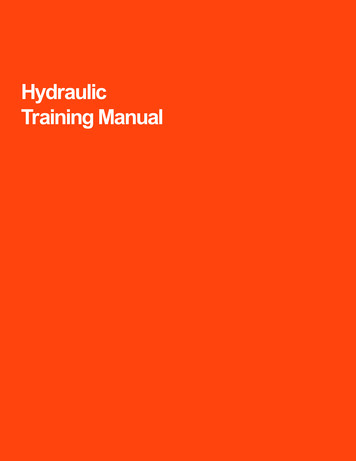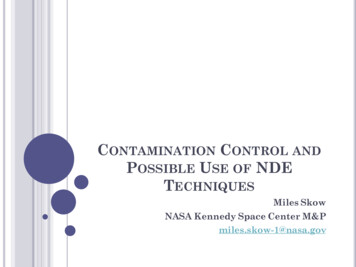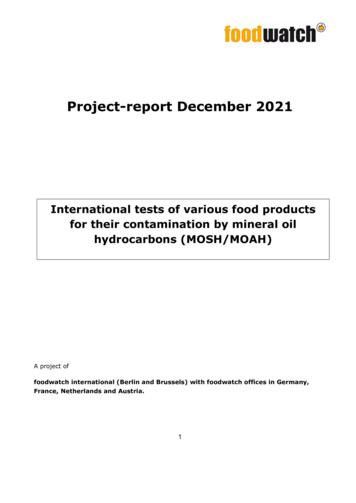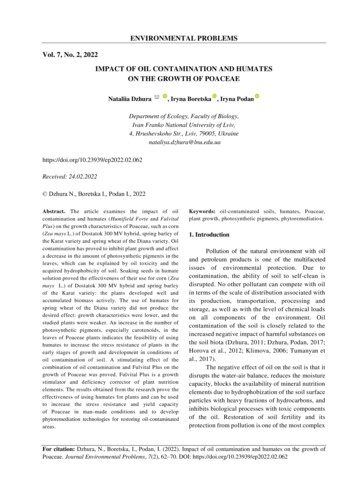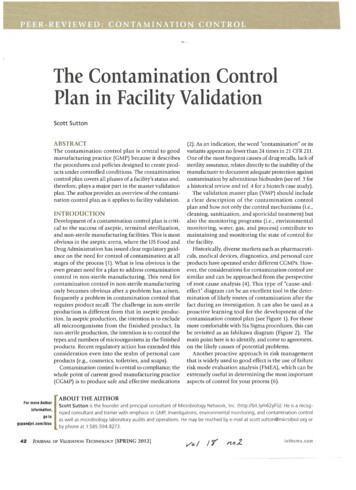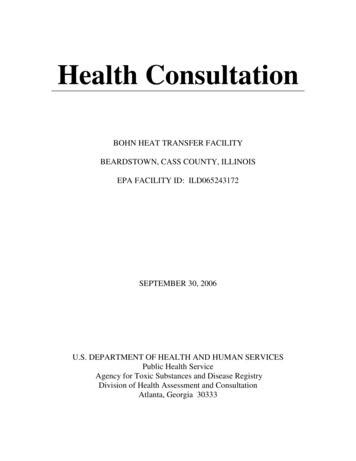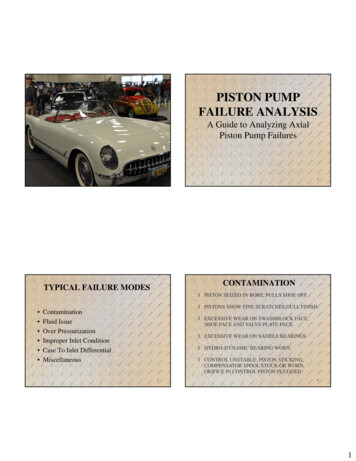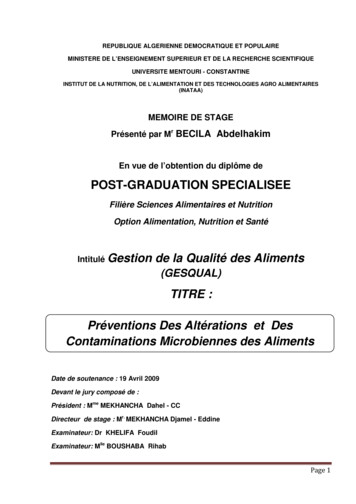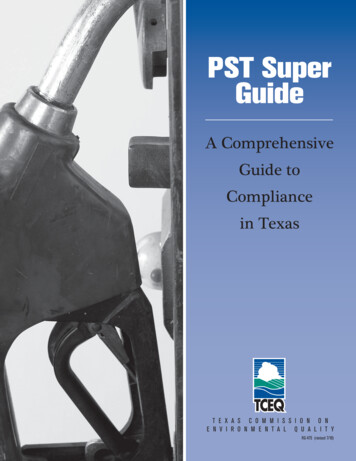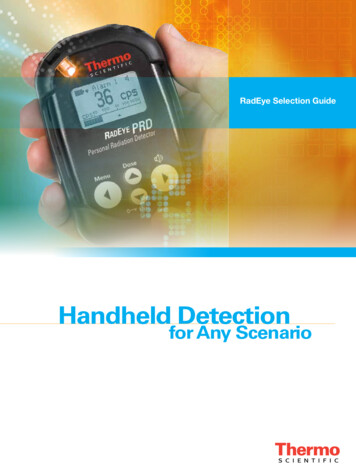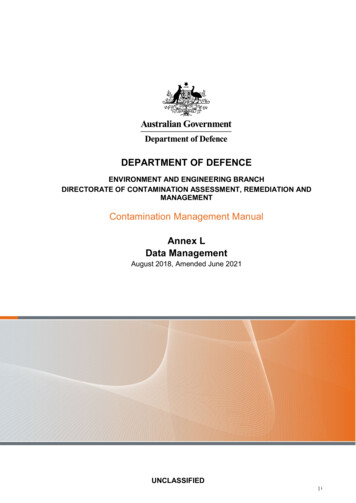
Transcription
DEPARTMENT OF DEFENCEENVIRONMENT AND ENGINEERING BRANCHDIRECTORATE OF CONTAMINATION ASSESSMENT, REMEDIATION ANDMANAGEMENTContamination Management ManualAnnex LData ManagementAugust 2018, Amended June 2021UNCLASSIFIED i
Commonwealth of Australia 2018This work is copyright. Apart from any use as permitted under the Copyright Act1968, no part may be reproduced by any process without prior written permissionfrom the Australian Government Department of Defence.Announcement statement—may be announced to the public.Secondary release—may be released to the Australian Government Department ofDefence, its contractors and their equivalents in United States of America, Canada,New Zealand and Great Britain.All Defence information, whether classified or not, is protected from unauthoriseddisclosure under the Crimes Act 1914. Defence information may only be released inaccordance with the Defence Security Manual as appropriate.First edition 2018SponsorDirectorate of Contamination Assessment, Remediation and ManagementDeveloperDirectorate of Contamination Assessment, Remediation and ManagementIssued byAssistant Secretary Environment and Engineering BranchEffective DateAugust 2018Amendment DateJune 2021Review DateJune 2022 or when changes to processes require an updateAmendments to the document can be proposed as required. Proposals foramendment of this document are to be forwarded to:Director of Contamination Assessment, Remediation and ManagementEmail: ncrp@defence.gov.auUNCLASSIFIED ii
Quick Reference GuideWhy is this an issue for Defence?Commercial RiskDefence may be exposed tofinancial and reputationalrisk caused by incompleteor inaccurate contaminationdata and reporting.Defence CapabilityProject data and reporting thatis not readily accessible or hasbeen incorrectly captured cancause project delays andassociated costs that impact onDefence’s capability.HSE RiskDefence personnel, contractorsand site users may be exposedto work health and safety riskswhere contaminated site data isnot readily accessible to informsite work procedures.Mandatory requirementsThe following data management requirements are mandatory when undertaking Defencecontamination investigation, assessment and remediation projects on the Defence estate: The Garrison Estate Management System, Environmental Factor Management – ContaminatedSites Records (GEMS EFM – CSR) must be reviewed. Data and reports generated from contamination investigation, assessment and remediationprojects are captured in the GEMS EFM – CSR. CSRs must be updated or created asnecessary to reflect the contamination status of a property. Updates must be supported bytechnical reports, risk assessments and spatial data to be submitted for upload with the records. All contaminated land data captured for the project is to be undertaken in accordance withAnnex L and the detailed guidance available on GEMS Gateway and Defence Estate QualityManagement System (DEQMS). In particular:–Spatial data is to be captured or created and submitted in accordance with the SpatialData Management Plan (SDMP) and this Annex, for update in Defence spatial systems.–Field and analytical data (including but not limited to soil, water, sediment, and vapour) isto be captured in accordance with the Defence Environmental Data ManagementSoftware (EDMS) requirements.–The Contamination Risk Assessment Tool (CRAT) must be applied in accordance withthe Defence Contamination Assessment Sequence and the guidance provided within thetool. Completed CRATs must be submitted to support proposed changes wheneverupdates are required to the risk rating for any CSR in GEMS. For Stage 2 Detailed SiteInvestigations (DSIs), this includes completing a risk workshop with appropriate Defencestakeholders.Where to get help or more information Defence Contamination Management Manual CRAT National Spatial Information Management Systems (NSIMS) and the SDMP GEMS Gateway including the Guide to the CSR fields in GEMS, the Frequently AskedQuestions, GEMS EFM - CSR and the supporting appendices to Annex LUNCLASSIFIED iii
AbbreviationsAbbreviationMeaningADESAssistant Director, Environmental and SustainabilityAHDBONSAustralian Height DatumNational Environment Protection (Assessment of Site Contamination) Measure1999 (Cth) (amended 2013)Biosecurity and Overabundant Native SpeciesCADComputer Aided DesignCDMSContamination Data Management SystemCFICapital Facilities and InfrastructureCOCChain of custodyCRATDCARMContamination Risk Assessment Tool (an excel workbook)Contaminated Site Record (data relating to a specific contaminated area withina Property)Defence is the Department of Defence and the Australian Defence Force(ADF)Directorate of Contamination Assessment, Remediation and ManagementDCDDefence Contamination DirectiveDCMMDefence Contamination Management ManualDEDDefence Estate DictionaryDefence PMDefence Project ManagerDEPACDirectorate of Environmental Planning, Approvals and ComplianceDEQMSDefence Estate Quality Management SystemDOPDilution of PrecisionDPNDefence Protected EnvironmentDSIDetailed Site InvestigationE&IGEstate and Infrastructure GroupEDMSEnvironmental Data Management SoftwareEDVPEnvironmental Data Visualisation PortalEFREnvironmental Factor RecordEFMEnvironmental Factor ManagementEHSMEnvironmental Health and Safety Management for Hazards and IncidentsEILEnvironmental investigation levelEMOSEstate Maintenance and Operations ServicesEPAEnvironment Protection Authority or AgencyEPBC ActEnvironment Protection Biodiversity Conservation Act 1999 (Cth)EPEEstimated precision ErrorERIMEstate Register Information ModelEScISEarth Science Information SystemsESMEnvironment and Sustainability ManagerESOEnvironment and Sustainability OfficerASC NEPMCSRDefenceUNCLASSIFIED iv
AbbreviationMeaningGCSGeographic Coordinate SystemGEMSGarrison Estate Management SystemGarrison Estate Management System Environmental Factor Management Contaminated Site RecordGEMS EFM – CSRGEMS GEOGarrison Estate Management Systems Geometries-Enabled ObjectsGDLBulk upload/download GEMS Data Load toolGISGeographic Information SystemGCSGeographic Coordinate SystemGNSSGlobal Navigation Satellite SystemsIDMIdentity ManagementLOCRDefence Legal Obligations and Compliance Registerm bglmetres below ground levelM bTOCMetres below top of casingMETMetadata Entry ToolNEPCNational Environment Protection CouncilNEPMNational Environment Protection MeasureNSIMSNational Spatial Information Management SystemOMPOngoing Monitoring PlanPCAPre-construction Contamination AssessmentPCSRPotential Contaminated Site RecordPDSProject Delivery ServicesPEPProperty Environmental Profile (is a summary of the key environmental issues,status and assessments conducted across the entire Property)PFASPer- and Poly-Fluoroalkyl SubstancesPFASIMPFAS Investigation and ManagementPSIPreliminary Site InvestigationQA/QCQuality Assurance / Quality ControlRCIPRegional Contamination Investigation ProgramRICORoutine Investigation Close OutSafetyManDefence Safety ManualSAPSystems Applications and Products in Data ProcessingSAQPSampling Analysis and Quality PlanSDMPSpatial Data Management PlanSDPSpatial Data PackageSMESubject matter expertsSPRSource-Pathway-ReceptorUNCLASSIFIED v
AbbreviationMeaningSAPSystems Applications and Products in Data ProcessingTOCTop of CasingUSTUnderground storage tankWHS ActWork Health and Safety Act 2011 (Cth)WQMPWater Quality Monitoring PlanWRCPWartime Remnants Clean-up ProgramUNCLASSIFIED vi
Table of contentsQuick Reference Guide . iiiAbbreviations . iv1.2.3.4.5.Introduction. 11.1Background . 11.2Purpose . 11.3Defence documentation . 2Regulatory Overview . 32.1Overview . 32.2Contractual obligations . 5Defence Contamination Data Management System (CDMS) . 73.1Overview . 73.2Roles and responsibilities . 7Garrison Estate Management System (GEMS) . 104.1Overview of Contaminated Sites Records in GEMS . 104.2Property Environmental Profile . 114.3GEMS EFM-CSR Overview . 134.4Modifying and retrieving CSRs in GEMS . 154.5What data and documentation need to be provided for input to GEMS? . 194.6GEMS EFM – CSR Fields . 204.7Further assistance . 20Environmental Data Management Software (EDMS) – ESdat . 215.1Overview . 215.2When to upload data to Defence ESdat . 215.3Access to Defence ESdat . 235.4Project data lifecycle . 235.5Project set-up . 255.6Location and sample naming convention . 275.7Before field work . 335.8After field work . 365.9Project audit and finalisation . 405.10 Other considerations . 405.11 Specific location types . 415.12 Defence EDMS tools. 455.13 Further assistance . 456.Contaminated Sites Spatial Data . 466.1Overview . 466.2Defence Spatial Data Management Plan (SDMP) . 466.3National Spatial Information Management System (NSIMS). 48UNCLASSIFIED vii
6.4CSRs spatial representation in GEMS GEO. 506.5E&IG GIS . 516.6Sampling location data storage (EDMS). 516.7CSR spatial data location or extent anomalies . 516.8Spatial dataset attribute table structures . 516.9Metadata . 566.10 GIS data delivery checklist . 576.11 Further assistance . 607.References . 61Table indexTable 3-1Summary of CDMS stakeholder roles and responsibilities. 7Table 4-1GEMS business functions & processes . 10Table 4-2Outline of training pathways for key Business Roles to access GEMS EFM-CSR . 14Table 4-3Outline of when and how to create a new CSR in GEMS . 16Table 4-4Outline of when and how to update information of an existing CSR in GEMS . 17Table 4-5Outline of when and how to merge existing CSRs . 17Table 4-6Outline of when and how to archive a CSR in GEMS . 18Table 4-7Outline of when and how to retrieve archived CSRs record in GEMS . 19Table 5-1Defence ESdat data upload requirements . 22Table 5-2EDMS project types . 25Table 5-3QA/QC sample naming convention . 28Table 5-4Location naming convention . 29Table 5-5Types of field data. 38Table 5-6Biota naming convention . 43Table 6-1Main user groups of SDMP . 47Table 6-2Key SDMP Sections relating to CSRs . 47Table 6-3CSR dataset attribute table structure. 52Table 6-4Other future contamination spatial dataset requirements . 56Table 6-5GIS data delivery checklist for contamination project/activity . 58Figure indexFigure 1-1Defence environmental documentation and Annex L . 2Figure 3-1Overview of CDMS . 7Figure 4-1Environmental components of GEMS in relation of PEPs and CSRs . 11UNCLASSIFIED viii
Figure 4-2PEP in GEMS – example Blamey Barracks . 12Figure 4-3PEP Contaminated Sites in GEMS – example Blamey Barracks . 12Figure 4-4GEMS EFM-CSR flow diagram . 14Figure 5-1EDMS project lifecycle . 24Figure 5-2EDMS project naming convention . 25Figure 5-3Sample naming convention . 28Figure 5-4Location and sample naming for three common monitoring well scenarios . 32Figure 5-5Adding locations of unknown origins in EDMS . 34Figure 5-6Reserving locations in EDMS . 35Figure 5-7Decommissioned and replaced locations in Defence EDMS . 37Figure 5-8Repaired wells with new TOC in Defence EDMS . 38Figure 5-9Private locations in Defence EDMS . 42Figure 5-10 Co-located samples in Defence EDMS – example for surface water and fishsampling co-locations . 44AppendicesAppendix A – Defence EDMS (ESdat) ToolsAppendix B – ESdat Sample Location and Well InformationAppendix C – CSR GIS file Fields and AttributesUNCLASSIFIED ix
1.Introduction1.1BackgroundContamination investigation, assessment, and remediation projects generate environmentaldata about the nature and extent of contamination on the Defence estate. The data is used tosupport and to inform risk based decision making throughout the estate life cycle.This document describes the requirements for Defence Project Managers (PMs) andcontractors/consultants for the creation, collection, and submission of contaminated land dataduring the delivery of contamination investigation, assessment, and remediation projects acrossthe Defence estate.Appropriate management of data associated with contamination investigations will assistDefence to minimise risks to human health and the environment and to avoid impacts onDefence capability and reputation. Use of current, accurate and accessible contaminated landdata will support Defence to maximise the value from investment in the conduct ofcontamination investigations across the estate.This Annex L should be read with reference to all other relevant material in the DefenceContamination Management Manual (DCMM) on the Defence Estate Quality ManagementSystem (DEQMS).1.2PurposeThis guidance is to assist Defence personnel and contractors to collect and report analyticaldata (including but not limited to that of soil, water, sediment, vapour) in the correct formats andto comply with the Defence business processes for the Contamination Data ManagementSystem (CDMS). The CDMS (Section 3) includes the following Defence Data Systems: The Garrison Estate Management System (GEMS) (see Section 4) Environmental Data Management Software (EDMS) - ESdat for field and analytical data(see Section 5) The National Spatial Information Management System (NSIMS) for current repository ofCSR Source area, location and extent (see Section 6)It also includes Defence guidance documents (such as this annex), forms and other tools.UNCLASSIFIED1
1.3Defence documentationThis gudiance document is an Annex to the DCMM and supports the compliance with sitecontamination management policy as detailed in the Defence Environment and HeritageManual. An overview of where this Annex fits into the Manual is presented in Figure 1-1.Figure 1-1 Defence environmental documentation and Annex LUNCLASSIFIED2
2.Regulatory Overview2.1OverviewDefence and its contractors must operate to comply with all Commonwealth legislation.Reference can be made to the Defence Legal Obligations and Compliance Register (LOCR),which is designed to provide both guidance on environmental legal obligations and as a tool tomanage compliance to these obligations.Defence may not be subject to State and Territory law in all situations. Whether or not Defenceis bound by State and Territory law is a complex issue and legal advice must be obtained toconfirm whether a particular State or Territory law is applicable to Defence. Defence contractorsmust comply with relevant State or Territory laws.2.1.1Refer to DCMMfor details onthe applicationof assessmentstages asdescribed inthe NEPM fortheAssessment ofSiteContaminationNEPMThe National Environment Protection (Assessment of Site Contamination) Measures 1999 (Cth)(the ASC NEPM) was made under the National Environment Protection Council Act 1994 (Cth)(NEPC). The ASC NEPM is the national guidance document for the assessment of sitecontamination in Australia. It is given effect by the National Environment Protection Measures(Implementation) Act 1998 (Cth) for the Commonwealth and individual legislation and guidelinesin each State and Territory.The NEPC agreed to vary the NEPM by approving an amending instrument to the ASC NEPMin 2013.All assessments of site contamination on the Defence Estate are to be undertaken inaccordance with the recommended process and guidance provided in the ASC NEPM.The purpose of the ASC NEPM is to establish a nationally consistent approach for theassessment of site contamination, to ensure sound environmental management practices by thecommunity, including regulators, site assessors, site contamination consultants, environmentalauditors, landowners, developers and industry parties.The desired outcome of the ASC NEPM is to provide adequate protection of human health andthe environment, where contamination has occurred, through the development of an efficientand effective national approach to the assessment of site contamination.The ASC NEPM and schedules are available for download through the NEPC website. TheASC NEPM Toolbox contains additional information including calculators, spreadsheets andother supporting documents to assist with application of the ASC NEPM.2.1.2Work Health and Safety Act 2011 (Cth)The Work Health and Safety Act 2011 (Cth) (WHS Act) commenced in 2012 and is regulated byComcare, a Commonwealth Government agency that works in partnership with the Safety,Rehabilitation and Compensation Commission. The WHS Act provides for a nationallyconsistent framework to protect workers and other persons against harm to their health andsafety through the elimination or minimisation of the risks to the extent reasonably practicable.Under the WHS Act, employers must take all reasonably practicable steps to ensure the healthand safety of its employees and those who are at or near a workplace under the employer'scontrol. This means that Defence and its contractors have obligations to protect the health andsafety of workers and others operating within the vicinity of contaminated land that is on or nearto a workplace under Defence control.UNCLASSIFIED3
Model Codes of Practice administered by Safe Work Australia provide practical guides toachieve the standards of health, safety and welfare required under the WHS Act.Any controls outlined in the Defence Safety Manual (SafetyMan) must be implemented whenmanaging contaminated materials.2.1.3Environment Protection and Biodiversity Conservation Act 1999(Cth)The Environment Protection and Biodiversity Conservation Act 1999 (Cth) (EPBC Act) is theAustralian Government’s central piece of environmental legislation. It provides a legalframework to protect and manage nationally and internationally important flora, fauna,ecological communities and heritage places, defined in the EPBC Act as matters of nationalenvironmental significance.The EPBC Act protects: The environment, where actions proposed are on, or will affect Commonwealth land andthe environment. The environment, anywhere globally on land and water, where a Commonwealth agency –including the Department of Defence – are proposing to take an action.The nine matters of national environmental significance to which the EBPC Act applies are: World heritage properties National heritage places Wetlands of international importance (Ramsar wetlands) Listed threatened species and communities Listed migratory species Commonwealth marine areas The Great Barrier Reef Marine Park Nuclear actions (including uranium mining) A water resource in relation to coal seam gas development and large coal miningdevelopmentDefence uses a comprehensive environmental impact assessment and approval program tounderstand and manage the impacts of its activities on the environment and heritage, and toensure compliance with the EPBC Act.Under the Defence Environment and Heritage Manual, the Director of Environmental Planning,Assessment and Compliance (DEPAC) is the Defence technical authority for determiningcompliance with the EPBC Act. All matters that may trigger the EPBC Act are to be referred toDEPAC.DEPAC undertakes a self-assessment against the Significant Impact Guidelines 1.1 – Mattersof National Environmental Significance and Guidelines 1.2 - Actions on, or impacting upon,Commonwealth Land and Actions by Commonwealth Agencies, published by the Department ofAgriculture, Water and the Environment to determine whether an action is likely to have a‘significant impact’ on a matter of national environmental significance protected by the EPBCAct.UNCLASSIFIED4
The self-assessment process considers the nature and extent of contamination and if thepresence, disturbance, removal or remediation of existing contamination is likely to have asignificant impact on EPBC Act protected matters. Where a significant impact to theenvironment is ‘likely’, the action must be referred to the Minister for the Environment to make adetermination on whether a proposed action is a ‘controlled action’.For more information with regard to the EPBC Act refer to http://www.environment.gov.au/epbc/.2.1.4Defence Legal Obligations and Compliance RegisterDefence and its contractors must operate to comply with all Commonwealth legislation,including the WHS Act, EPBC Act and the ASC NEPM. In addition, Defence and its contractorsshould be generally familiar with the legislative and other regulatory requirements associatedwith the site activities undertaken relevant to the State or Territory in which the site is located.Contractors must comply with State and Territory laws where applicable. Reference can bemade to the LOCR which is designed to provide both guidance on environmental legalobligations and as a tool to manage compliance to these obligations.2.2Contractual obligationsContamination investigations undertaken on the Defence Estate and Defence leased assets areto be undertaken in accordance with existing Defence business processes as outlined in theDCMM and available on DEQMS and GEMS Gateway.All contractors undertaking contamination investigations are responsible for complying withthese processes.UNCLASSIFIED5
3.Defence Contamination DataManagement System (CDMS)3.1OverviewThe Defence Contamination Data Management System (CDMS) comprises three main datasystems (GEMS, EDMS and geospatial), associated guidance and processes, and other toolsthat present and interrogate data from various sources.Figure 3-1 shows a broad overview of the CDMS in the context of projects that consultants willundertake on the Defence estate and where further information can be found within this annex.ConsultantsDefenceInvestigations andRisk AssessmentsDCMM Annex LRemediationSection 4Managing PEPsReview and update GEMSEFM-CSR recordsMonitoringEstate ProjectsSection 5User access and project set-upProject data lifecycleAudit and finalisationSection 6Review of GEMS EFM-CSRSpatial boundariesDefence Contamination DataManagement SystemsGEMSEDMS (ESdat)GeospatialFigure 3-1 Overview of CDMS3.2Roles and responsibilitiesThe main input of contamination-related data from the Defence estate to the CDMS is viaconsultants, so it is imperative that all relevant stakeholders are aware of their roles andresponsibilities. A summary of the roles and responsibilities of both the consultant and Defencestakeholders is provided in Table 3-1.Table 3-1 Summary of CDMS stakeholder roles and responsibilitiesRoleResponsibilitiesConsultant Project TeamConsultantProjectManager Be the primary point of contact for project related issues and questionsbetween Defence and the Consultant Project Delivery Team Be aware of requirements (outlined in this annex) for data managementand deliverables for their project and ensure they are met Review all deliverables for compliance against Defence requirements Be aware of communications between other consultant project teammembers (e.g. Consultant Defence EDMS (ESdat) User) and DefenceOFFICIAL7
RoleResponsibilitiesConsultantProjectDeliveryTeam Be aware of requirements (outlined in this annex) for data managementand implement these during project delivery (e.g. planning, field work,reporting and data delivery) Review relevant existing information in the GEMS EFM-CSR andassociated contamination assessment / remediation reports Prepare update of GEMS EFM-CSR using the GEMS Data Load tool (GDL)spreadsheet, accurately reflecting the results a
Annex L and the detailed guidance available on GEMS Gateway and Defence Estate Quality Management System (DEQMS). In particular: - Spatial data is to be captured or created and submitted in accordance with the Spatial Data Management Plan (SDMP) and this Annex, for update in Defence spatial systems.
